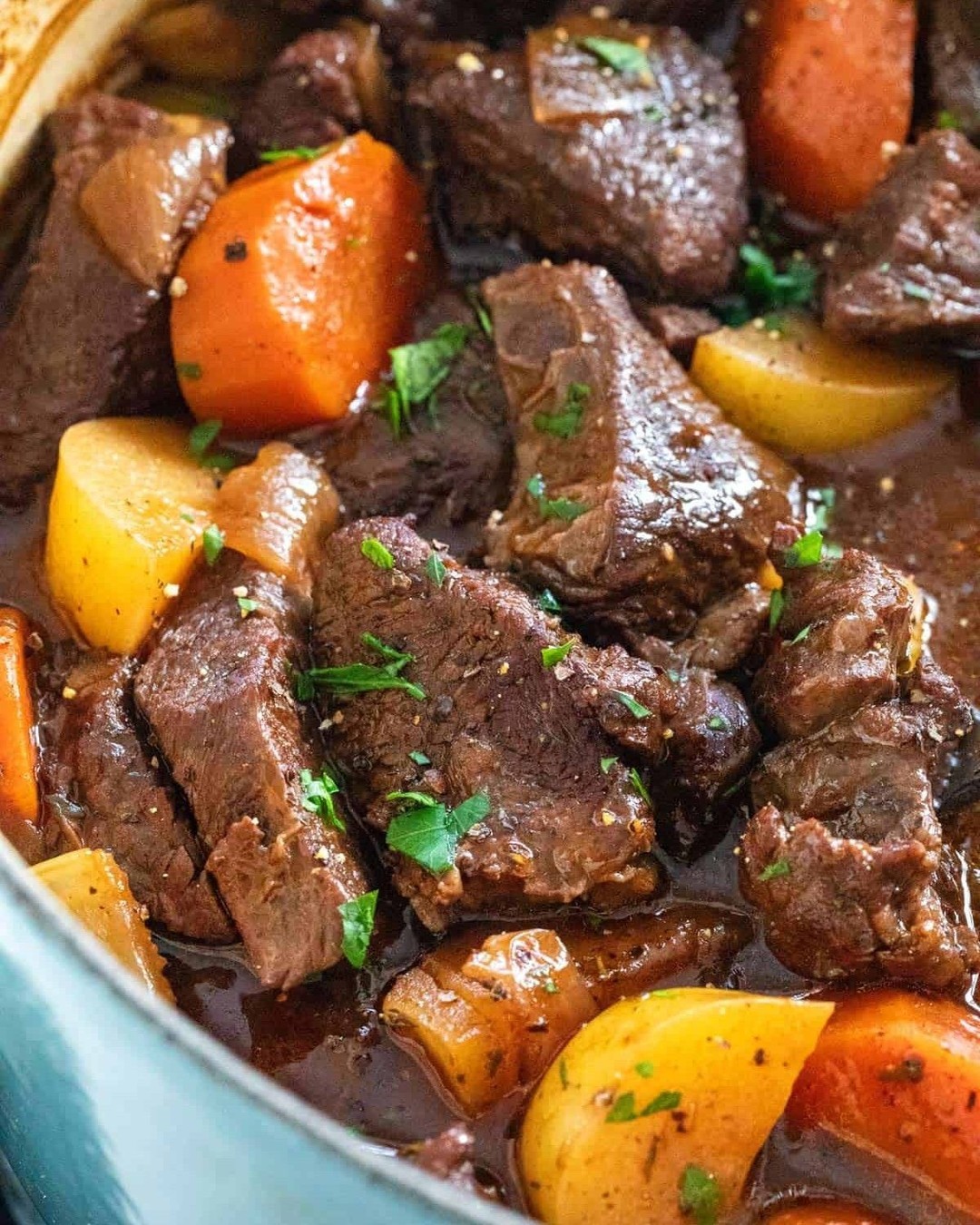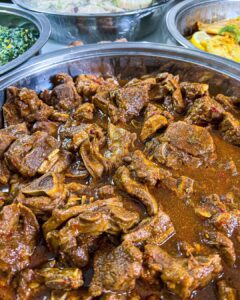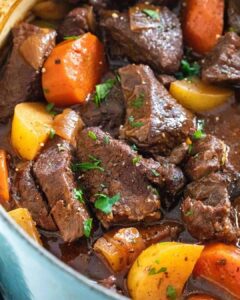Beef Stew Recipe: A Hearty and Delicious Guide

Beef Stew Recipe: A Hearty and Delicious Guide
Introduction

Craving a warm, hearty meal that brings comfort and satisfaction? Look no further than a classic beef stew! This article will guide you through everything you need to know to make a delicious beef stew that will impress your family and friends. From selecting the best ingredients to perfecting the cooking process, we’ve got you covered.
What is Beef Stew?
Beef stew is a savory dish made with chunks of beef, vegetables, and a flavorful broth. It’s a one-pot meal that has been enjoyed for centuries across various cultures. Traditionally, it’s known for its rich taste and ability to warm you up on a cold day.
Benefits of Beef Stew
Nutritional Benefits: Beef stew is packed with protein, vitamins, and minerals. The beef provides essential nutrients like iron and zinc, while the vegetables contribute fiber and vitamins.
Comfort Food Aspects: There’s something incredibly comforting about a bowl of beef stew. It’s a meal that brings people together and creates a sense of warmth and home.
Versatility in Meals: Beef stew can be enjoyed as a main dish, paired with bread or rice, or even used as a filling for pies and casseroles.
Ingredients Needed

To make the perfect beef stew, you’ll need the following ingredients:
- Beef: Opt for chuck roast or stew beef, as these cuts become tender when slow-cooked.
- Vegetables: Carrots, potatoes, onions, and celery are staples.
- Seasonings and Spices: Garlic, thyme, bay leaves, salt, and pepper are essential for flavor.
Equipment Required
Having the right tools can make the cooking process smoother:
- Essential Kitchen Tools: A large pot or Dutch oven, cutting board, sharp knife, and wooden spoon.
- Optional Tools for Enhancement: Slow cooker, instant pot, or a ladle for serving.
Preparation Tips
Selecting the Best Beef: Choose beef with good marbling, as the fat adds flavor and tenderness.
Prepping Vegetables: Cut vegetables into uniform pieces to ensure even cooking.
Seasoning Techniques: Season the beef generously before browning to enhance the flavor.
Step-by-Step Recipe
Step 1: Preparing the Ingredients
- Cut the beef into 1-inch cubes.
- Peel and chop the vegetables into bite-sized pieces.
- Mince the garlic and set aside.
Step 2: Browning the Beef
- Heat a tablespoon of oil in a large pot over medium-high heat.
- Add the beef in batches, browning all sides. Remove and set aside.
Step 3: Cooking the Vegetables
- In the same pot, add more oil if needed.
- Sauté onions, carrots, and celery until softened.
- Add garlic and cook for another minute.
Step 4: Combining Ingredients
- Return the beef to the pot.
- Add potatoes, bay leaves, thyme, salt, and pepper.
- Pour in beef broth to cover the ingredients.
Step 5: Simmering to Perfection
- Bring to a boil, then reduce heat to low.
- Cover and let it simmer for 1.5 to 2 hours, stirring occasionally, until the beef is tender.
Cooking Variations
Slow Cooker Method: Follow the preparation steps, then transfer everything to a slow cooker. Cook on low for 6-8 hours or high for 3-4 hours.
Instant Pot Method: Use the sauté function for browning and cooking vegetables. Add all ingredients, then pressure cook on high for 35 minutes.
Oven-Baked Method: After browning and combining ingredients, transfer the pot to a preheated oven at 325°F and cook for 2-3 hours.
Serving Suggestions
Pair your beef stew with these sides for a complete meal:
- Crusty bread or rolls
- Mashed potatoes
- A fresh green salad
For presentation, garnish with fresh parsley or a sprinkle of grated cheese.
Storing and Reheating
Store leftovers in an airtight container in the fridge for up to 4 days. For longer storage, freeze the stew in portion-sized containers for up to 3 months. To reheat, simply warm on the stove over medium heat or microwave until hot.
Common Mistakes to Avoid
- Overcooking the Beef: This can make the meat tough. Keep an eye on the simmering time.
- Using the Wrong Cuts: Avoid lean cuts that can become dry. Stick to well-marbled options.
- Skipping the Browning Process: Browning adds depth and richness to the flavor.
Healthier Alternatives
- Low-Fat Options: Trim excess fat from the beef and use less oil.
- Adding More Vegetables: Incorporate additional veggies like mushrooms, bell peppers, or peas for more nutrients.
Tips for Enhancing Flavor
- Using Fresh Herbs: Add a sprig of rosemary or a handful of fresh thyme.
- Incorporating Wine or Beer: Deglaze the pot with red wine or a dark beer for an extra layer of flavor.
- Adding a Touch of Sweetness: A teaspoon of brown sugar or a splash of balsamic vinegar can balance the savory flavors.
Advantages of Beef Stew
Nutritional Value: Beef stew is a nutrient-dense meal, providing a good balance of protein, carbohydrates, and vitamins.
Ease of Preparation: With simple ingredients and a straightforward cooking process, beef stew is easy to prepare, making it a great option for beginners and experienced cooks alike.
Economical Meal Option: Using affordable cuts of beef and common vegetables, beef stew is a cost-effective way to feed a family.
Disadvantages of Beef Stew
Long Cooking Time: Beef stew requires a long simmering time to achieve tender meat and deep flavors, which might not be ideal for a quick meal.
Potential for High Fat Content: Depending on the cut of beef used, the stew can be high in fat. Opting for leaner cuts and trimming excess fat can help reduce this.
Possible Dietary Restrictions: Some individuals may have dietary restrictions that prevent them from consuming beef stew, such as vegetarians or those with certain health conditions.
Conclusion
Beef stew is a timeless dish that brings together the best of comfort and nutrition. With this guide, you’re well-equipped to create a beef stew that’s sure to become a favorite in your household. So, gather your ingredients, follow the steps, and enjoy a bowl of homemade goodness.
FAQs
What cut of beef is best for stew?
Chuck roast or stew beef are ideal due to their marbling and tenderness when cooked slowly.
Can I make beef stew without potatoes?
Yes, you can substitute potatoes with other root vegetables like parsnips or turnips.
How long can I store beef stew in the fridge?
Beef stew can be stored in the fridge for up to 4 days in an airtight container.
Can I freeze beef stew?
Absolutely! Freeze it in portion-sized containers for up to 3 months.
What can I use to thicken beef stew?
Cornstarch or flour mixed with water can be added during the simmering process to thicken the stew.
